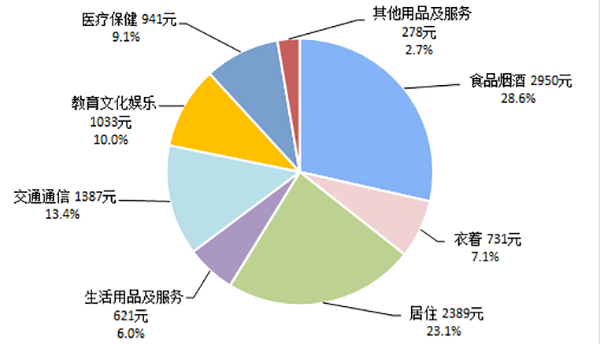China’s "consumption map" came out: How much did you spend in the first half of the year?
Beijing, July 31 (Reporter Tang Ming) According to World Finance, the economic voice of the Central Radio and Television General Station, the data released by the National Bureau of Statistics showed that in the first half of this year, the per capita consumption expenditure of the national residents reached 10,330 yuan, and consumption is still an important driving force to lead the stable economic growth. With the release of economic data of provinces (autonomous regions and municipalities) in the first half of the year, a more detailed "consumption map" is presented to people: where do residents spend the most money? Where is the fastest growth in consumption?
The per capita consumption expenditure is generally higher than last year.
In the first half of this year, the ranking of per capita consumption expenditure of residents in various provinces (autonomous regions and municipalities) was basically the same as last year, and the amount of consumption expenditure generally increased compared with last year. The data shows that the top rankings of per capita consumption expenditure in the first half of this year were Shanghai, Beijing, Tianjin, Zhejiang and Guangdong, which were consistent with the first half of last year.
Among them, Beijing’s per capita consumption expenditure exceeded 20,000 yuan, Hubei, Chongqing and Inner Mongolia exceeded 10,000 yuan. In the first half of this year, the per capita consumption expenditure exceeded 10,000 yuan, an increase of three compared with the same period last year.
The southeast coastal market is huge, and the western region is growing rapidly.
Looking at the "consumption map" in the first half of the year, the strong economic provinces in the southeast coast are generally stable and the consumer market is huge. Among the top 10 provinces (autonomous regions and municipalities) in the first half of the year, the southeast coastal provinces and municipalities accounted for half of the country, and the per capita consumption expenditures of Shanghai, Zhejiang, Guangdong, Jiangsu and Fujian all exceeded the national average, ranking in the forefront.
Although the consumption market in the central and western regions is not as large as that in the southeast coast, the growth rate is generally faster. Among them, the total retail sales of social consumer goods in Sichuan Province in the first half of the year increased by 10.5% year-on-year, and the growth rate was 2.1 percentage points higher than the national average.
Expanding consumption scenes in various places to stimulate consumption vitality
In order to further stimulate the vitality of consumption, many regions have expanded the consumption scene. Recently, Beijing residents have fully felt the changes brought by the "night economy" to people’s lives. Guangdong has issued the Implementation Plan for Improving the System and Mechanism of Promoting Consumption in Guangdong Province, and put forward 29 specific measures in nine aspects in view of the outstanding problems that restrict consumption at present. Among them, in order to optimize the automobile consumption environment, measures such as gradually relaxing the car lottery and auction indicators in Guangzhou and Shenzhen and expanding the scale of quasi-purchase were put forward.
Service-oriented, development-oriented, and experience-oriented consumption are featured.
With the development of mobile Internet technology, in the "consumption map" in the first half of the year, service-oriented consumption, developmental consumption and experiential consumption have become the consumption characteristics of all localities. For example, in the first half of the year, Shanghai’s retail sales without stores reached 117.3 billion yuan, an increase of 20.4% over the same period last year; The contribution rate of service consumption in Beijing to the total consumption growth reached 70.4%, and the contribution rate of upgrading consumption such as communication to the total consumption growth reached 60%.

Xing Ziqiang, chief economist of Morgan Stanley China, believes that in the future, 5G will inject new vitality into consumption. "The application of 5G is expected to help smart cities, the Internet of Things, the Internet of Vehicles and other applications to a big step, and finally make those more close to consumers. The vitality of tailor-made services, experiences, shopping and medical consumption will be further released, which may be the next stage."